CRUISING IN COMFORT
Page 46
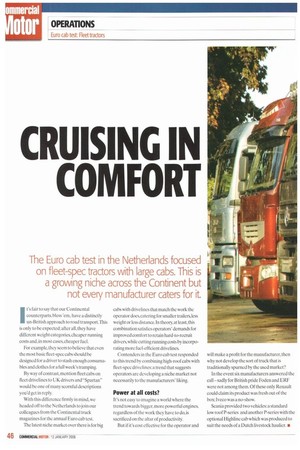
Page 47
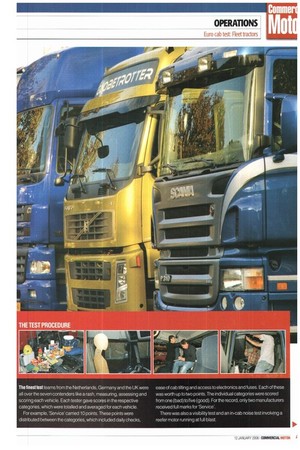
Page 48
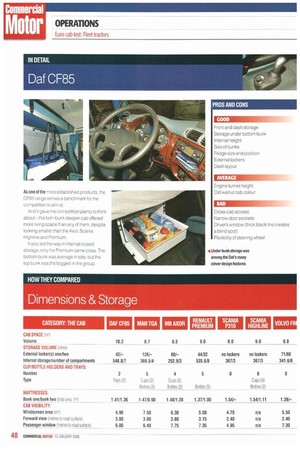
Page 49

Page 50
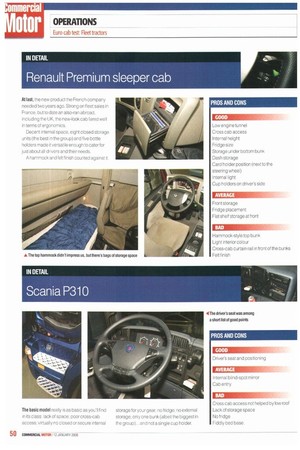
Page 51
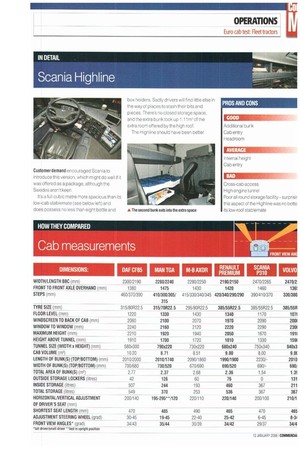
Page 52
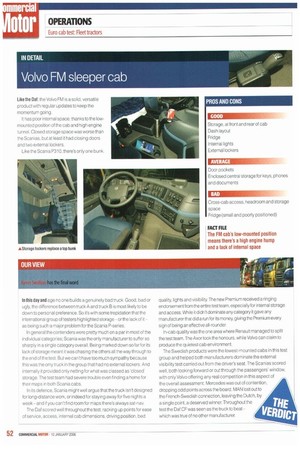
If you've noticed an error in this article please click here to report it so we can fix it.
The Euro cab test in the Netherlands focused on fleet-spec tractors with large cabs. This is a growing niche across the Continent but not every manufacturer caters for it
ICs fair to say that our Continental counterparts. bless 'em, have a distinctly un-British approach to road transport.This is only to he expected; after all, they have different weight categories, cheaper running costs and, in most cases, cheaper fuel.
For example, they seem to believe that even the most basic fleet-spec cabs should be designed for a driver to stash enough consumables and clothes for a full week's tramping.
By way of contrast, mention fleet cabs on fleet drivel ines to UK drivers and "Spartan" would be one of many scornful descriptions you'd get in reply With this difference firmly in mind, we headed off to the Netherlands to join our colleagues from the Continental truck magazines for the annual Euro cab test.
The latest niche market over there is for big cabs with drivelines that match the work the operator does,catering for smaller trailers, less weight or less distance. In theory,at least, this combination satisfies operators' demands for improved comfort to retain hard-to-recruit drivers, while cutting running costs by incorporating more fuel-efficient drivelines.
Contenders in the Euro cab test responded to this trend by combining high-roof cabs with fleet-spec drivelines: a trend that suggests operators are developing a niche market not necessarily to the manufacturers' liking.
Power at all costs?
It's not easy to imagine a world where the trend towards bigger, more powerful engines, regardless of the work they have to do, is sacrificed on the altar of productivity.
But if it's cost effective for the operator and will make a profit for the manufacturer, then why not develop the sort of truck that is traditionally spurned by the used market?
In the event six manufacturers answered the call —sadly for British pride Foden and ERF were not among them. Of these only Renault could claim its product was fresh out of the box:Iveco was a no-show.
Scania provided Iwo vehicles:a standard low roof P-series and another P-series with the optional Highline cab which was produced to suit the needs of a Dutch livestock haulier. THE TEST PROCEDURE
The finest test teams from the Netherlands, Germany and the UK were all over the seven contenders like a rash, measuring, assessing and scoring each vehicle Each tester gave scores in the respective categories, which were totalled and averaged for each vehicle For example, 'Service carried 10 points These points were distributed between the categories, which included daily checks, ease of cab tilting and access to electronics and fuses Each of these was worth up to two points The individual categories were scored from one (bad) to five (good) For the record, only two manufacturers received full marks for 'Service'.
There was also a visibility test and an in-cab noise test involving a reefer motor running at full blast As one of the "ore established products, the CF85 range serves a benchmark for the competition to aim at And it gave the competition plenty to think about—this twin-bunk sleeper cab offered more living space than any of them, despite looking smaller than the Axor, Scania Highline and Premium.
It also led the way in internal closed storage; only the Premium came close. The bottom bunk was average in size, but the top bunk was the biggest in the group.
ROS AND CONS
GOOD Front and dash storage Storage under bottom bunk Internal height Size of bunks Fridge size and position External lockers Dash layout
I I I I I irir
Engine tunnel height Old walnut cab colour Cross-cab access Narrow door pockets Driver's window (thick black line creates a blind spot) Flexibility of steering wheel Alter a strong start In the UK the MAN TGA XL sleeper cab is starting to struggle. Its internal cab dimensions, for example, proved to be less than average for this group.
External storage, however, put MAN at the top of the class, with its closed internal storage edging ahead of the Scania P310 to take third place— but it was still far behind the French and Dutch efforts.
The top bunk (or hammock) was the smallest second bunk in the group. PROS AND CONS Cross-cab access Storage volume and position, including c and driver's door Fridge as standard
EZEZE■1111L
Internal height Dark dash Versatility of steering wheel BAD Hammock-style top bunk with no added mattress Heavy bottom bunk impedes storage access behind seats Light coloured interior will age quickly FACT RLE Impressive storage space and a fridge as standard are bound to help keep your drivers busy—and loyal Built to cater specifically for the UK market, the Axor has grown in stature and confidence.
But despite its impressive headroom, the overall space for the driver was the smallest in the group, due in main to a narrow overall width and high engine tunnel. It also had the smallest internal storage volume for closed lockers, with just three compartments. But when it's time for bed the two bunks combined to offer the second largest sleeping area in the group, behind Oaf, PROS AND CONS GOOD Storage Large fridge Wide engine tunnel Internal light Central dash storage Cross-cab access (hampered by gearst Cab entry BAD Light colour interior Internal space
Renault Premium sleeper cab
At last, the new product the French company needed two years ago. Strong on fleet sales in France, but to date an also-ran abroad. including the UK, the new-look cab fared well in terms of ergonomics.
Decent internal space, eight closed storage units (the best in the group) and five bottle holders made it versatile enough to cater for just about all drivers and their needs.
A hammock and felt finish counted against it, ROS AND CONS GOOD
Low engine tunnel
Cross cab access Internal height Fridge size Storage under bottom bunk Dash storage Card holder position (next to the steering wheel) Internal light Cup holders on driver's side
AVERAGE 4'5
Front storage Fridge placement Flat shelf storage at front BAD Hammock-style top bunk Light interior colour Cross-cab curtain rail in front of the bunks Felt finish The basic mad& really is as basic as you'll find in its class: lack of space; poor cross-cab access; virtually no closed or secure Internal
storage for your gear; no fridge; no external storage; only one bunk (albeit the biggest in the group)... and not a single cup holder.
Driver's seat and positioning Internal blind-spot mirror Cab entry BAD Cross cab access not helped by low roof Lack of storage space No fridge Fiddly bed base. Customer demand encouraged Scania to introduce this version, which might do well if it was offered as a package, although the Swedes aren't keen.
Its a full cubic metre more spacious than its low-cab stablennate (see below left) and does possess no less than eight bottle and
box holders. Sadly drivers will find little else in the way of places to stash their bits and pieces. There's no closed storage space, and the extra bunk took up 1.11m3 of the extra room offered by the high roof.
The Highline should have been better. Additional bunk Cab entry Headroom AVERAGE Internal height Cab entry BAD Cross-cab access High engine tunnel Poor all round storage facility surprisir this aspect of the High line was no bette its low-roof stab lemate
Volvo FM sleeper cab
Like the Oat the Volvo FM is a solid, versatile product with regular updates to keep the momentum going.
It has poor internal space, thanks to the lowmounted position of the cab and high engine tunnel. Closed storage space was worse than the Scanias, but at least it had closing doors and two external lockers.
Like the Scania P310, there's only one bunk. PROS AND CONS GOOD Storage, at front and rear of cab Dash layout Fridge Internal lights External lockers
11=3111=1111110
Door pockets Enclosed central storage for keys, phones and documents BAD Cross-cab access, headroom and storage space Fridge (small and poorly positioned) FACT F1LE The FM cab's low-mounted position means there's a high engine hump and a lack of internal space -"has the final word .
In this day and age no one builds a genuinely bad truck. Good. bad or ugly, the difference between truck A and truck B is most likely to be down to personal preference. So it's with some trepidation that the international group of testers highlighted storage or the lack of it as being such a major problem for the Scania P-series.
In general the contenders were pretty much on a par in most of the individual categories; Scania was the only manufacturer to suffer so sharply in a single category overall. Being marked down so far for its lack of storage meant it was chasing the others all the way through to the end of the test But we can't have too much sympathy because this was the only truck in the group that had no external lockers. And internally it provided only netting for what was classed as 'closed' storage. The test team had severe trouble even finding a home for their maps in both Scania cabs.
In its defence, Scania might well argue that the truck isn't designed for long-distance work, or indeed for staying away for five nights a week and if you can't find room for maps there's always sat-nay.
The Daf scored well throughout the test, racking up points for ease of service, access, internal cab dimensions, driving position. bed quality, lights and visibility. The new Premium received a ringing endorsement from the entire test team, especially for internal storage and access. While it didn't dominate any category it gave any manufacturer that did a run for its money, giving the Premium every sign of being an effective all-rounder.
In-cab quality was the one area where Renault managed to split the test team. The Axor took the honours. while Volvo can claim to produce the quietest cab environment.
The Swedish products were the lowest-mounted cabs in this test group and helped both manufacturers dominate the external visibility test carried out from the driver's seat. The Scanias scored well, both looking forward or out through the passengers' window, with only Volvo offering any real competition in this aspect of the overall assessment. Mercedes was out of contention, dropping odd points across the board. MAN lost out to / the French-Swedish connection, leaving the Dutch, by / a single point, a deserved winner. Throughout the test the Daf CF was seen as the truck to beatwhich was true of no other manufacturer.
























































































































































































